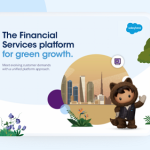We live in a digital world. This truth affects nearly everything you can imagine, including the future of banking.
Moving towards digital banking experiences isn’t just about the bottom line. It benefits customers and employees alike, with improved interactions between teams, reduced turnaround times for customers, and personalised insights. Ahead, we dive further into what digital banking has to offer.
A digital-first experience for employees
The banking customer experience is essential and so is the employee experience. In fact, the two are linked: satisfied employees result in increased customer satisfaction. For this reason, the future of digital banking starts with staff members.
Digitising processes and data can improve workflows and address employee pain points. The ability to communicate is a significant part of this, with digital spaces bringing colleagues together. The financial technology company Revolut is using Slack as its digital HQ.
During the pandemic, Slack was key for helping companies go remote. Speaking with Salesforce at World Tour London, Revolut’s VP, Head of Global Sales, Matthew Acton-Davis, said, “Slack was one of the tools that allowed us to move to a completely remote environment and workplace.”
Since the introduction of remote working, Revolut has continued to expand its use of Slack. “We’re now looking at Slack and the integration we have in order to provide a much better customer experience by integrating it with our onboarding teams, with our risk teams, and with our fin[ancial] crime departments in order to make sure that we’re delivering well for our customers.”
Banking companies can also move employee training into the digital space. This makes training more accessible for onboarding and continued education. When trained in digital banking, customer-facing employees can better help customers.
Salesforce’s online learning platform, Trailhead, allows companies to assign training materials to their employees. It also provides structure to onboarding processes. Matthew describes Trailhead as “fundamental for the way we operate in sales at Revolut”. Trailhead helps train Revolut’s sales representatives so that they can meet the financial organisation’s requirements. Revolut’s staff can also track performance as employees grow in their careers.
Learn more about the future of banking and how Revolut has used Salesforce to support its success in our on-demand Salesforce+ episode.



Using automation and AI to enhance customer experiences
Financial institutions can use artificial intelligence (AI) and automation to improve the banking customer experience. Uses of AI include chatbots and cybersecurity programs. Chatbots can help solve small concerns for existing customers, with a quick response time regardless of the time of day. This frees employees to focus on larger issues.
Automation produces similar benefits. By automating the sales process, sellers can focus on the customers they’re in conversation with. At the same time, the ones they aren’t in active conversation with go into passive streams. These streams keep the bank on their radar. This allows employees to increase conversion rates while maintaining a pipeline of customers. Revolut uses this strategy, with Matthew saying, “When they’re ready to talk to us, we’re again delivering that wow moment.”
Data allows for product expansion tailored to customer needs
Digital banking experiences provide financial institutions with data on their customers, their experiences, and the products they use. This also includes the issues they have and the types of questions they ask. This information can help companies expand their products and personalise experiences.
Take how financial institutions have responded to investors caring about climate change and social justice, for example. Customers can now discover stocks and funds from companies with environmental, social, and governance values that align with their own.
Digital services that help customers with financial planning have also been born out of this access to data. Some banks offer tools where customers can set their goals and receive guidance along the way. This eliminates the need for a secondary app.
Revolut has recognised that customers’ approach to buying is changing. “Customers spend far more time doing research about our products, than actually speaking to us”, shares Matthew. Revolut uses technology to help customers with this research. He says, “If we looked back five years ago, no one would have thought sending tailored videos to each of your prospects would’ve been realistic. And now it seems par for the course.”
Expanding product offerings helps financial institutions grow their audience while serving customers better. In early 2022, Revolut launched payroll and spend management solutions. These efforts come back to the same goal: saving customers time and money.
Learn how Revolut is wowing its customers using Salesforce
Revolut uses Salesforce to wow its customers with enhanced digital banking experiences and to support the company’s expansion. Launched in 2015, the company is now working with 500,000 businesses and more than 18 million retail customers. As Matthew shares in our interview, “Demand has never been higher for Revolut business.” As demand increases, so do Revolut’s offerings. It’s now impressing customers with on-demand pay, crypto trading and equities trading, and perks and rewards. Learn more about the future of banking and how Revolut has used Salesforce to support its success in our on-demand Salesforce+ episode.
Watch the ‘Revolut and the Future of Digital Banking Experiences’ episode on Salesforce+ to learn more.



























